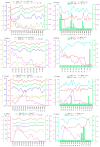Influence of Meteorological Factors on the COVID-19 Transmission with Season and Geographic Location
- PMID: 33435301
- PMCID: PMC7827058
- DOI: 10.3390/ijerph18020484
Influence of Meteorological Factors on the COVID-19 Transmission with Season and Geographic Location
Abstract
The purpose of this study is to investigate whether the relationship between meteorological factors (i.e., daily maximum temperature, minimum temperature, average temperature, temperature range, relative humidity, average wind speed and total precipitation) and COVID-19 transmission is affected by season and geographical location during the period of community-based pandemic prevention and control. COVID-19 infected case records and meteorological data in four cities (Wuhan, Beijing, Urumqi and Dalian) in China were collected. Then, the best-fitting model of COVID-19 infected cases was selected from four statistic models (Gaussian, logistic, lognormal distribution and allometric models), and the relationship between meteorological factors and COVID-19 infected cases was analyzed using multiple stepwise regression and Pearson correlation. The results showed that the lognormal distribution model was well adapted to describing the change of COVID-19 infected cases compared with other models (R2 > 0.78; p-values < 0.001). Under the condition of implementing community-based pandemic prevention and control, relationship between COVID-19 infected cases and meteorological factors differed among the four cities. Temperature and relative humidity were mainly the driving factors on COVID-19 transmission, but their relations obviously varied with season and geographical location. In summer, the increase in relative humidity and the decrease in maximum temperature facilitate COVID-19 transmission in arid inland cities, while at this point the decrease in relative humidity is good for the spread of COVID-19 in coastal cities. For the humid cities, the reduction of relative humidity and the lowest temperature in the winter promote COVID-19 transmission.
Keywords: community-based pandemic prevention and control; geographical location; precipitation; relative humidity; season; temperature; wind speed.
Conflict of interest statement
The authors declare no conflict of interest.
Figures


Similar articles
-
A meta-analysis result: Uneven influences of season, geo-spatial scale and latitude on relationship between meteorological factors and the COVID-19 transmission.Environ Res. 2022 Sep;212(Pt B):113297. doi: 10.1016/j.envres.2022.113297. Epub 2022 Apr 15. Environ Res. 2022. PMID: 35436453 Free PMC article.
-
The Influence of Average Temperature and Relative Humidity on New Cases of COVID-19: Time-Series Analysis.JMIR Public Health Surveill. 2021 Jan 25;7(1):e20495. doi: 10.2196/20495. JMIR Public Health Surveill. 2021. PMID: 33232262 Free PMC article.
-
Association between meteorological factors and daily new cases of COVID-19 in 188 countries: A time series analysis.Sci Total Environ. 2021 Aug 1;780:146538. doi: 10.1016/j.scitotenv.2021.146538. Epub 2021 Mar 23. Sci Total Environ. 2021. PMID: 34030332 Free PMC article.
-
Multi-outputs Gaussian process for predicting Burkina Faso COVID-19 spread using correlations from the weather parameters.Infect Dis Model. 2022 Sep;7(3):448-462. doi: 10.1016/j.idm.2022.06.006. Epub 2022 Jul 9. Infect Dis Model. 2022. PMID: 35845472 Free PMC article. Review.
-
A systematic review and meta-analysis on correlation of weather with COVID-19.Sci Rep. 2021 May 24;11(1):10746. doi: 10.1038/s41598-021-90300-9. Sci Rep. 2021. PMID: 34031526 Free PMC article.
Cited by
-
Data analysis evidence beyond correlation of a possible causal impact of weather on the COVID-19 spread, mediated by human mobility.Sci Rep. 2024 Aug 1;14(1):17782. doi: 10.1038/s41598-024-67918-6. Sci Rep. 2024. PMID: 39090143 Free PMC article.
-
A meta-analysis result: Uneven influences of season, geo-spatial scale and latitude on relationship between meteorological factors and the COVID-19 transmission.Environ Res. 2022 Sep;212(Pt B):113297. doi: 10.1016/j.envres.2022.113297. Epub 2022 Apr 15. Environ Res. 2022. PMID: 35436453 Free PMC article.
-
Relationship between meteorological factors and mortality in patients with coronavirus disease 2019: A cross-sectional study.Heliyon. 2023 Jul 22;9(8):e18565. doi: 10.1016/j.heliyon.2023.e18565. eCollection 2023 Aug. Heliyon. 2023. PMID: 37576230 Free PMC article.
-
Effect of Seasonal Land Surface Temperature Variation on COVID-19 Infection Rate: A Google Earth Engine-Based Remote Sensing Approach.Environ Health Insights. 2022 Oct 16;16:11786302221131467. doi: 10.1177/11786302221131467. eCollection 2022. Environ Health Insights. 2022. PMID: 36262201 Free PMC article.
-
The impact of meteorological factors and PM2.5 on COVID-19 transmission.Epidemiol Infect. 2022 Jan 21;150:e38. doi: 10.1017/S0950268821002570. Epidemiol Infect. 2022. PMID: 35057873 Free PMC article.
References
-
- WHO Coronavirus Disease (COVID-19) Outbreak Situation. [(accessed on 11 November 2020)]; Available online: https://www.who.int/
-
- CNR Many Countries in Europe “Closed City”! Why is the Second Outbreak More Serious than the First. [(accessed on 29 October 2020)]; Available online: http://www.cnr.cn/
-
- Dhruv G. Effect of ambient temperature on COVID-19 infection rate. SSRN. 2020:7. doi: 10.2139/ssrn.3558470. - DOI
MeSH terms
LinkOut - more resources
Full Text Sources
Other Literature Sources
Medical

